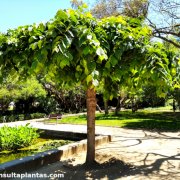Care of the tree Morus nigra or Black mulberry |
|
The genus Morus, family Moraceae, includes about 15 species of trees native to Asia, America, Africa and southern Europe. Some species are: Morus nigra, Morus alba, Morus rubra, Morus australis, Morus mesozygia. Common names: Black mulberry, Blackberry. This species is native to central Asia. They are deciduous trees with a rounded crown that reach 15 meters (49.21 feet) in height. The large leaves are up to 15 cm (5.9") long, have a rough texture and are deep green on the upper side and hairy on the underside. The small, non-decorative flowers appear in dense spikes. They bloom in spring. The edible fruits are green and then black; they taste sweet and sour and contain a lot of vitamin C. Black mulberry is used as shade trees in small groups or as isolated specimens and in public streets and parks. Morus nigra needs full sun exposure and prefers a rainy climate although it can grow in a Mediterranean climate. It resists frost. The ideal soil should be deep, slightly calcareous and contain abundant organic matter. Planting is done in spring or autumn. Water regularly so the substrate never dries out completely. Blackberry does not resist drought. In Mediterranean climates increase irrigation in summer. Fertilize with compost or manure in the fall. Morus nigra does not need pruning. Black mulberry usually does not present serious pest and disease problems. Morus nigra is propagated from seeds sown in spring and by grafting. |
Images of the tree Morus nigra or Black mulberry |
Find plants
Morus nigra or Black mulberry | Care and Growing
© 2025 FavThemes



